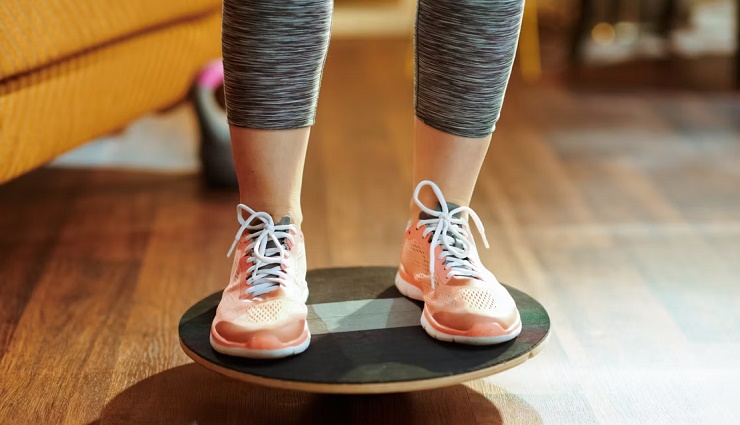Regular exercise and physical activity improve physical health and positively affect mental health. There are helpful tools and devices to make physical exercises harder and more effective, including the balance board. Exercising on the unstable surface of these boards increases strength and improves body balance and coordination. In the following, we will learn more about the balance board, its types, and the benefits and harms of practicing with it. In the end, we describe some simple exercises to get started.
What is a balance board?
A balance board is a flat surface placed on a round or cylindrical base, creating an unstable surface. Usually, the balance board is wooden and moves in different directions. Exercising with these boards forces you to use your core muscles and constantly adjust your movements and posture to maintain balance. The balance board is a versatile and effective tool that is useful for any age and level of fitness. Using this board alone or together with metal dumbbells or barbells improves health and physical performance.
Types of balance boards
1. wobble boards
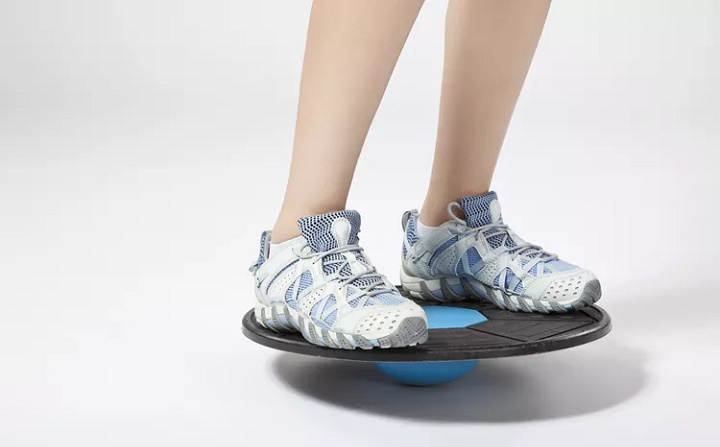
There are round boards that move in all four directions, right, left, front, and back, and they can also move in rotation.
2. rocker board

They are usually rectangular and have a U-shaped protrusion in the lower part or a curved shape similar to the letter U. The rocker board only moves in two directions: right and left or forward and backward.
3. balance discs
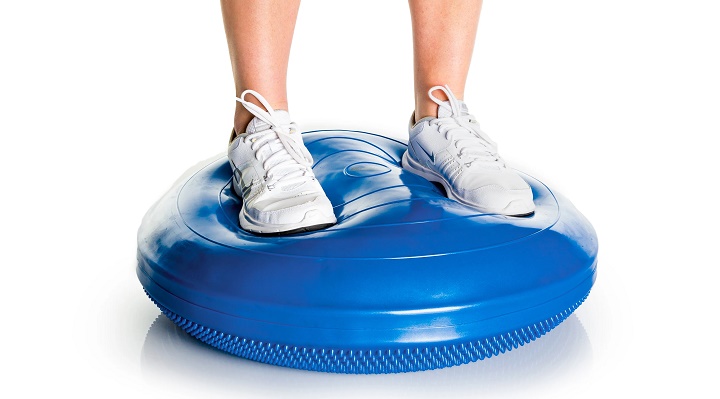
It is a cushion for central muscles, balance, and stretching exercises.
Advantages of using a balance board
Balance boards can strengthen specific muscle groups, such as the core, calves, and ankles. By doing squats or other exercises on this board, you can strengthen stabilizing muscles and increase your strength and fitness. We have explained other benefits of using these boards below.
1. Physiotherapy and rehabilitation applications
One use of the balance board is physiotherapy; it is also used in rehabilitation environments. Physical therapists use balance boards to rehabilitate lower leg injuries (especially ankle sprains). These boards help patients recover after injury or surgery, build strength and flexibility, and improve balance and coordination. Balance boards are the perfect exercise tool to prevent sports injuries and protect against falls at all ages.
In a small study, those stroke patients who performed balance board exercises in addition to conventional physical therapy improved their balance more than the control group who did not use the balance board.
2. Improve balance
The ability to maintain balance depends on the functioning of 3 body systems:
- visual system;
- vestibular system (a sensory device in vertebrates that creates a sense of balance in movement and informs about the orientation and spatial position of the body to establish movement coordination);
- Proprioceptive system.
Exercising with a balance board strengthens proprioception. Proprioception is our understanding of the position of our body and our movements in three-dimensional space, that is, how well our body can sense its location, movements, and actions. Experts believe that ankle proprioception plays an essential role in creating balance. With a balance board, you can train your muscles, ligaments, and tendons to work better together to stabilize your ankle.
A new study found that proprioceptive training using a balance board reduces the likelihood of repeated ankle sprains or first-time sprains.
3. Increase physical strength
Like any other form of resistance training, using a balance board forces the muscles to work harder than usual. Depending on your exercises, this results in more muscular leg, core, and upper body muscles. In addition, using a balance board allows you to have better body control and overall stability, which is helpful for sports and martial arts activities.
4. Increased coordination
By challenging your body to maintain stability on an unstable surface, you have to coordinate your movements and muscle activation more precisely. This leads to better neuromuscular coordination, which is essential for many complex activities, such as playing musical instruments or typing on a keyboard. In addition, improving coordination plays a role in preventing injuries and performing daily activities better.
5. Relieve joint pain
Exercising with a balance board is a great way to take pressure off your joints and reduce discomfort. The balance board is very effective, whether standing or sitting on it. According to research, balancing movements involve the muscles and increase the range of motion, like a kind of massage for the joints. In addition to lubricating the joint, this increases blood flow and reduces inflammation and stiffness (which cause pain). In addition, exercise with a balance board strengthens the muscles around the joints and provides more support and stability. As a result, the pressure on the ligaments and tendons that hold them together is reduced.
6. Help to lose weight
Any form of physical activity burns calories. Therefore, using a balance board may also be helpful for weight loss. In a small study, the difference in energy consumption was investigated for 30 healthy adults at work. The researchers measured the participants’ energy expenditure while sitting, standing on a flat surface, and standing on a balance board. The participants typed for one and a half hours, including 30 minutes in each of the three mentioned positions, and the energy consumption when using the balance board was 14.2% higher than when sitting.
Disadvantages of a balance board
As with any exercise equipment, improper use of the balance board can cause problems. The biggest problem with a balance board is one of the things that makes it such a great fitness tool: you have to balance on an unstable surface. Improving balance and strengthening the ankles is one of the most essential advantages of this type of exercise. However, if you have weak or injured ankles, knee or hip problems, or limitations in your balance, using a balance board creates problems such as increasing the likelihood of falling.
If you’re new to exercise or have problems with your ankles, hips, or knees, work out under the supervision of a qualified physical therapist or personal trainer. They can teach you how to use the balance board correctly.
Balance board exercises
If you’re new to balance board training, it’s best to do these exercises near a wall or a stable surface like a table so you can rest your hands on them. You can do all the exercises in your training session with the balance board.
1. Basic balance exercise
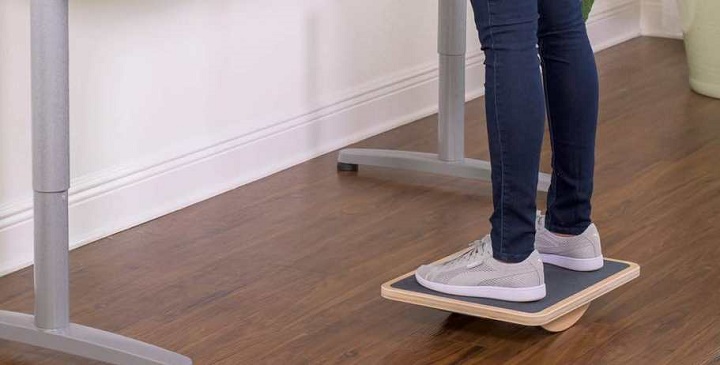
This exercise starts with standing on the board, moves back and forth, and ends with a side-to-side movement. It involves the hip, quadriceps, hamstrings, legs, and central muscles and improves stability, coordination, and spatial awareness.
- Get on the board and distribute your weight evenly over its surface so that the edges do not touch the ground. To do this exercise, spread your legs shoulder-width apart and keep your head forward. Focusing on a point in front of you effectively maintains your balance. Keep your body upright and spine straight. Maintain your balance in this position for 30 seconds.
- Slowly bend the board forward until it makes contact with the ground. Then, slowly tilt it back until it touches the floor behind you. You can keep your hands in front of you or at your sides. Slowly tilt the board back and forth for 30 seconds.
- Stand in the initial balance position. Gently tilt the board left and right. Tilt the board from one side to the other for 30 seconds.
2. One leg balance
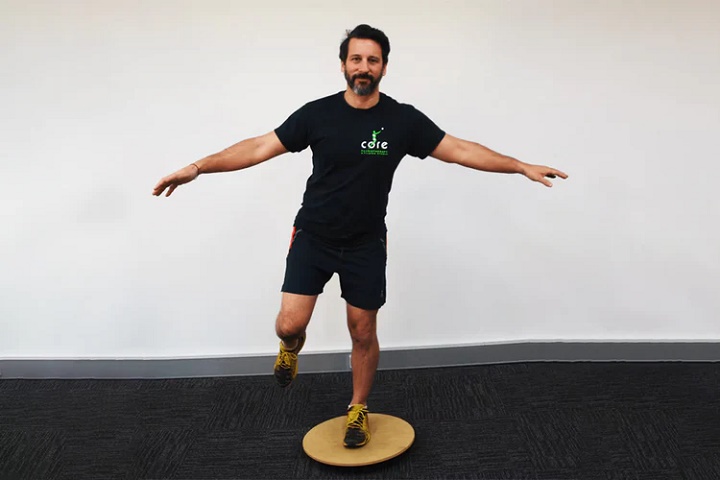
After practicing standing balance, challenge yourself by standing on one leg. To perform this exercise, lift one leg off the board and stay in this position for at least 30 seconds. Then, change the position of the legs. This exercise improves balance, especially on uneven surfaces.
3. squat
The squat is a great lower-body exercise; adding a balance board makes it even more difficult. Squat exercise with a balance board strengthens the glutes, quadriceps, hamstrings, calves, and core.
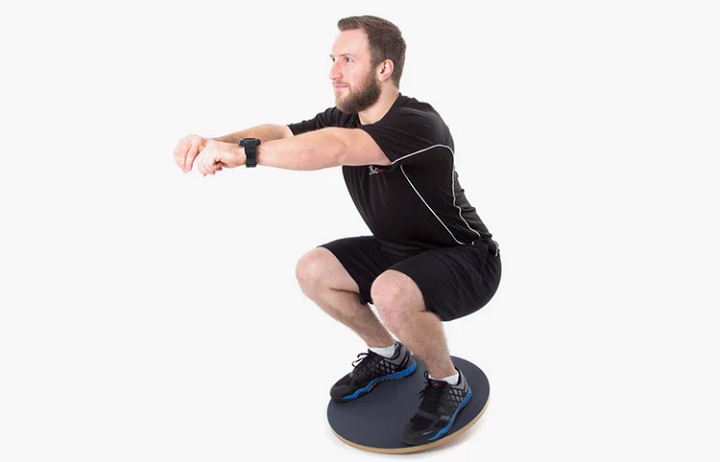
To do this exercise, stand on the board and spread your legs slightly wider than the width of your hips. For balance, you can place your arms in front of you or at your sides or your hands on a wall or a stable surface. Slowly bend the knees. Lower your body just enough to keep your balance. Stand up by pressing your heels together. Do this exercise 10 to 15 times.
4. Reverse long
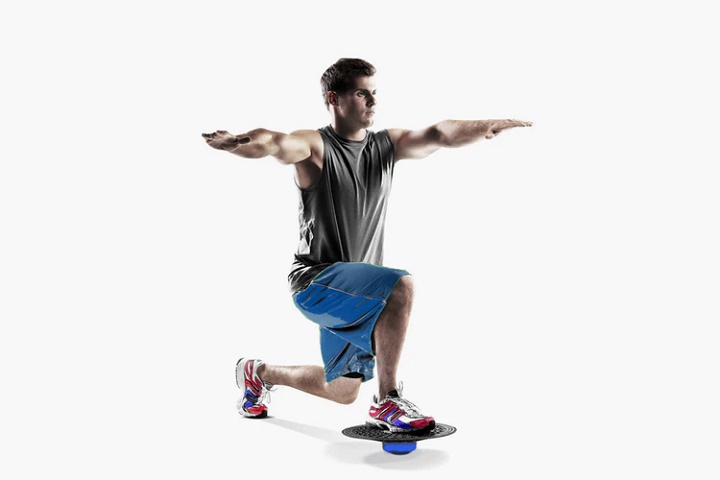
The reverse lunge with the balance board strengthens the glutes, hamstrings, and quadriceps and improves balance. To do this exercise, get on the board and step back with your right foot. Lower your body until the left knee bends at a 90-degree angle. Then, return to the initial position and do the same steps with the other side of the body. Do this exercise 10 times with each leg.
5. Plank

Plank with a balance board strengthens the muscles of the abdomen (central), buttocks, legs, shoulders, back, and arms. To perform this exercise in a swimming position, place your hands on the board and open them a little more than shoulder-width apart. (Place your legs together for more of a challenge and spread them apart for more stability.) Keep your body in a straight line by engaging your core muscles. Keep your hands straight, but slightly bend your elbows. Stay in this position for 30 seconds or as long as you can.
6. Swim
This exercise takes the plank movement and engages the chest, triceps, and core muscles. To perform this exercise in a swimming position, place your hands on the balance board at a distance slightly more than shoulder-width apart. (For a more advanced version of the exercise, pair your legs and spread them apart for more stability.) Your body should be in a straight line.

Engaging your core muscles, bend your elbows and slowly lower your body as far as you can while keeping your body in a straight line. Pause for a moment and then return to the starting position. Do this exercise 5 to 10 times.
7. Glute bridge
This exercise strengthens the glutes, hamstrings, and central muscles. To do it, lie on your back and bend your knees. Place your hands on both sides of your body and your feet on the balance board. The soles of the feet must be in contact with the balance board. By engaging the muscles of the buttocks, press the legs on the balance board to lift the hips off the floor. Go as high as you can while maintaining your balance. Contract the gluteal muscles and stay in this position for a few seconds. Then, slowly lower your body. Do this movement 10 to 15 times.
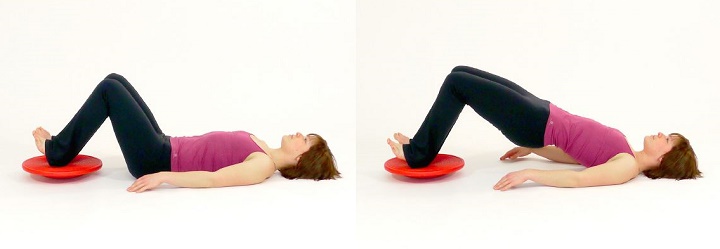
It is better for beginners to start with short training sessions of 5 to 10 minutes and gradually increase the session time. As you progress to balance board training, you can have longer training sessions of 30 minutes or more.
you say
Using a balance board is an attractive way to change and vary your workouts and challenge yourself in a new way. Have you ever worked out on a balance board? What effect has using this tool had on your muscles and sports performance?
Warning! This article is only for educational purposes; to use it, it is necessary to consult a doctor or specialist.
